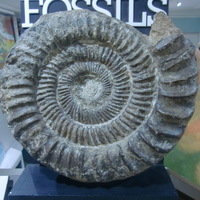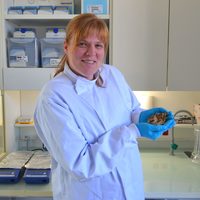collembola by Rafael Jordana
Papers by Rafael Jordana

<i> Entomobrya lamingtonensis</i> Schött, 1917<i> sensu</i> Jordana &... more <i> Entomobrya lamingtonensis</i> Schött, 1917<i> sensu</i> Jordana &amp; Greenslade ( Figs 2E, 4 M–N, 23A–J)<b> Holotype</b>. Female, locality and collection details of type locality given above.<b> Other material examined.</b> Two females, one cleared, one dark, QLD, Emu Vale, 20 km E Warwick, - 28.2284°S, 152.2419°E, 515m asl, in rotten log, 14.v.1974, PG leg. [ SAMA]; 2 males, one cleared the other dark, TAS, Claremont, near Hobart, Cadbury's factory, - 42.793°S, 147.267°E, 12m asl, 4.viii.1966, Ireson leg.; one specimen cleared on slide with 2 dark females, WA, Perth, - 31.986°S, 115.822°E, 7m asl, 18.xi.1930, HW leg.; 4 specimens, 2 female cleared and female and juvenile (dark blue) on same slide below 2 cover slips, 2 specimens, not cleared and both remounted, WA, Perth, Kings Park, - 31.96°S, 115.83°E, 23m asl, wet land, 16.viii.71, M. Johnson leg. [ SAMA].<b> Redescription.</b> Size. Length up to 1.49 mm excluding antennae ( Holotype) (n=11 at1339 μm). Colour. Blue dark with white patches in each chaetal insertion. Ground colour uniform pale yellow; head and every dorsal segment dark blue, with some bleached areas. Ant and legs light blue. Only the furca yellowish. ( Fig. 4M, N). Head. Eight eyes, G, H half the size of E and F. Antennal length 543 μm (n= 6) Holotype without antennae, 1.99 times the length of the head (n=6). Ant IV with bilobed apical vesicle without pin chaeta; 1 small rod and a small sensillum near the tip of Ant IV. Relative length of Ant I / II / III / IV =1/1.8/1.8/2.8. Sensory organ of Ant III with rod-like sensilla in addition to 3 guard sensilla ( Fig. 23A); Ant I with 3 smooth chaetae at its base. Labral papillae with 2–5 projections. ( Fig. 23B). Labral formula 4/554, 4 prelabral chaetae ciliated, labral chaetae smooth. Labial chaetae MREL 1 L 2 all ciliated, only with one M, and R a little shorter than others (80% of M). Five rows of post labial ciliated chaetae. Labial papilla E with external process not reaching the papilla tip. Thorax and abdomen. Length ratio of Abd IV/III= [...]
FIGURES 25 – 30. Pygmarrhopalites cantavetulae sp. nov.: 25, foreleg (posterior view); 26, midleg... more FIGURES 25 – 30. Pygmarrhopalites cantavetulae sp. nov.: 25, foreleg (posterior view); 26, midleg (posterior view); 27, hind leg (posterior view); 28, claw of foreleg; 29, claw of mid leg; 30, claw of hind leg.
FIGURES 14–18. Sinhomidia bicolor male: 14, trochanteral organ; 15, coxal chaetotaxy legs 1, 2 an... more FIGURES 14–18. Sinhomidia bicolor male: 14, trochanteral organ; 15, coxal chaetotaxy legs 1, 2 and 3; 16, dens and mucro (only the spines are figured, not the chaetae neither their insertions), 17, male genital tract, 18, head chaetotaxy. Bar 14 = 25 µm, Bar 15,18 = 50 µm, Bar 16 and 17 = 0.1mm.
FIGURE 20. Pygmarrhopalites cantavetulae sp. nov., head chaetatoxy.
Zootaxa, Sep 21, 2021
The study of Onychiuridae from 42 caves of the north of the Iberian Peninsula and southwestern Fr... more The study of Onychiuridae from 42 caves of the north of the Iberian Peninsula and southwestern France has revealed the existence of 32 species inhabiting the caves of the Basque bio-speleological district, among which four new species are described: Deuteraphorura bizkaiensis sp. nov., Deuteraphorura bolivari sp. nov., Onychiurus arbailakensis sp. nov. and Protaphorura leitzaldeaensis sp. nov. Furthermore, three species, Deuteraphorura boneti (Gisin, 1953), Deuteraphorura akelaris (Jordana &amp;amp;amp; Beruete, 1983) and Spinonychiurus vandeli (Cassagnau, 1960), are redescribed based on type and new material to furnish the description of some characters, especially concerning the chaetotaxy, not considered in the original description. Keys to the recorded species are also reported.
Zenodo (CERN European Organization for Nuclear Research), Dec 31, 2006
Two new species of Entomobrya are described from two caves of Asturias and Cantabria (north of Sp... more Two new species of Entomobrya are described from two caves of Asturias and Cantabria (north of Spain). The specimens were found in the Bonet collembolan collection at the "Museo Nacional de Ciencias Naturales" of Madrid (Spain). Entomomobrya boneti n. sp. was found in three slides containing 11, 4 and 1 specimens respectively, from the "Cueva del Castillo", Puente el Viesgo (Santander). Entomobrya luquei n. sp. was found in a slide with 11 specimens from "Cueva de Cuetu-Lledías", Llanes (Asturias). The species are described considering a set of 39 morphological and chaetotaxy characters. Both species appear to be troglophiles by the pigment reduction, although there are no other troglomorphic characters present. The gut content is composed of organic matter and fungus spores.

En esta Memoria de Tesis doctoral se presenta un estudio de los mimáridos (Hymenoptera, Mymaridae... more En esta Memoria de Tesis doctoral se presenta un estudio de los mimáridos (Hymenoptera, Mymaridae) relacionados con el maíz en Navarra. Se han recogido 72 muestras en 60 puntos diferentes utilizando dos métodos de muestreo completamente diferentes: trampa 'Malasia' y captura directa con manga entomológica. La extracción ha sido directa bajo lupa binocular y se han separado 7.268 mimáridos de un total de 94.038 insectos y otros artrópodos. Representan el 7.72% del total. Estos mimáridos han sido clasificados y separados en 37 especies y 11 géneros diferentes. Los géneros Anagrus HALIDAY, 1833 y Gonatocerus NEES, 1834 han aparecido como los más relacionados con el cultivo del maíz en Navarra y dos de sus especies las más distribuidas por todo el territorio, en concreto Anagrus (Anagrus) atomus (LINNAEUS), 1767 y Gonatocerus litoralis HALIDAY, 1833. Se ha comprobado asimismo la presencia de la especie de cicadélido Zyginidia scutellaris (HERRICH-SCHÄFFER), 1838 (Homoptera, Cicadellidae) en todos los campos de maíz de Navarra. Dieciocho de las especies capturadas han aparecido escasamente representadas (ocho de ellas con un sólo individuo). Se ha comprobado la elevada presencia de insectos y de otros artrópodos en los campos de maíz debido a la ausencia de tratamientos químicos contra los insectos perjudiciales.

PubMed, Jun 1, 1975
The active transport of galactose across the intestinal wall (everted sacs) of the snail Cryptomp... more The active transport of galactose across the intestinal wall (everted sacs) of the snail Cryptomphalus hortensis Müller has been studied in vitro, under several metabolic conditions. Anaerobiosis does not change the serosal/mucosal galactose gradients which are developed in oxygen atmosphere. Dinitrophenol (10(-4) M) greatly increased the O2 uptake by the tissue and clearly inhibits the sugar transport. At 5 times 10(-4) M concentration, DNP totally prevents the uphill transport while the O2 uptake is normal. The inhibition produced by DNP does not increase by anaerobiosis. Fluoride inhibits the galactose transport and also the O2 uptake. It is deduced that in snail intestine the energy for the active transport of galactose can be supplied by aerobic as much as by anaerobic metabolism. The inhibition by dinitrophenol seems to be independent of its uncoupling action on the oxidative phosphorylation. The inhibitory effect of NaF may be due both to glycolisis inhibition and to alteration of the digestive epithelium.
Zootaxa, Mar 6, 2023
Three new species of soil Collembola from both agricultural lands (vineyards and olive orchards) ... more Three new species of soil Collembola from both agricultural lands (vineyards and olive orchards) and a natural habitat (beech forest) located in Sicily (Italy) are described: Superodontella eleonorae sp. nov., first record of this genus for Italy, Lepidocyrtus rapitalai sp. nov. and Pseudosinella francae sp. nov..
Zootaxa, Nov 30, 2017
A third species of the genus Sinhomidia is described from South China: S. uniseta sp. nov. This n... more A third species of the genus Sinhomidia is described from South China: S. uniseta sp. nov. This new species can be distinguished from the two other species of the genus by the following characters: colour pattern, single labial chaeta M, chaetotaxy on terga and ventral tube, unguis with three inner teeth, and 15 clypeal ciliated chaetae. Also, the chaetotaxy of the first instar of Sinhomidia is described for the first time in the present paper, and confirms the close relationship between Sinhomidia and Homidia. A key to species of Sinhomidia is provided.

Zenodo (CERN European Organization for Nuclear Research), Dec 31, 2010
In the present paper a new species, Homidia sichuanensis Jia, Zhang &amp; Jordana sp. nov. fr... more In the present paper a new species, Homidia sichuanensis Jia, Zhang &amp; Jordana sp. nov. from West China, is described and figured. The new species is separated from the other Homidia by the presence of macrochaeta p4 on Th. III and the distribution of macrochaetae on A6–A10 areas of Abd. IV. Using the description of this new species, the generalized chaetotaxy for Homidia is described and figured, following Szeptycki (1979) and Jordana and Baquero (2005). Dorsal macrochaetotaxy of all known Homidia species from China are provided. For first time we give the chaetotaxy for H. phjongiangica Szeptycki, 1973 from types, H. sauteri (Börner, 1909) from Japanese material, H. sinensis Denis, 1929 from types, H. socia Denis, 1929 from Japanese material and H. transitoria Denis, 1929 from types. A key to the Chinese species of Homidia with known chaetotaxy are also given.
... MA HERNANDEZ, MD MATEO, R. JORDANA Universidad de Navarra Departamento de Zoología PAMPLONA .... more ... MA HERNANDEZ, MD MATEO, R. JORDANA Universidad de Navarra Departamento de Zoología PAMPLONA ... al carrascal de Sansoain y robledal de Beunza; esto se explica por el mejor desarrollo en ellos del tapete herbáceo y micorrizas que son sus fuentes de alimento. ...
Zoology, Aug 1, 2020
This is a PDF file of an article that has undergone enhancements after acceptance, such as the ad... more This is a PDF file of an article that has undergone enhancements after acceptance, such as the addition of a cover page and metadata, and formatting for readability, but it is not yet the definitive version of record. This version will undergo additional copyediting, typesetting and review before it is published in its final form, but we are providing this version to give early visibility of the article. Please note that, during the production process, errors may be discovered which could affect the content, and all legal disclaimers that apply to the journal pertain.
Zootaxa, Oct 1, 2015
Pradesh. Collections were mainly made using an aspirator from leaf litter, mosses, under stones, ... more Pradesh. Collections were mainly made using an aspirator from leaf litter, mosses, under stones, flowering garden plants and river embankments, wetlands and rotting logs. Sixteen species were found, belonging to genera: Entomobrya, Himalanura, Homidia, Sinella, Willowsia, Lepidocyrtus (Acrocyrtus), Lepidocyrtus (Cinctocyrtus), Seira, Drepanosira and Salina. Twelve of these have been described as new species.
Zenodo (CERN European Organization for Nuclear Research), Dec 31, 2009
Isotominella geophila Delamare Deboutteville, 1948, from Massif Edough in Northeast Algeria, has ... more Isotominella geophila Delamare Deboutteville, 1948, from Massif Edough in Northeast Algeria, has been found for the second time and is redescribed. It is separated from all other genera of Isotomidae by the following combination of characters: absence of eyes and pigment, PAO oval, not subdivided, shorter than width of antennal base, dens partially crenulated, dental chaetotaxy with more than six setae (13+4), posterior central S-setae on thoracic tergite II to abdominal tergite IV in prow , S-seta on abdominal tergite V not thickened and mucro bidentate. This species exhibits sexual dimorphism.
Zoosystema, Sep 13, 2022
Habitus and color patterns of some species described in the article of Baquero et al. (2021).











Uploads
collembola by Rafael Jordana
Papers by Rafael Jordana